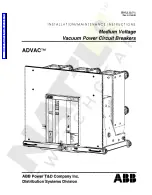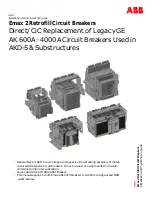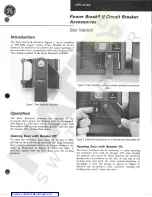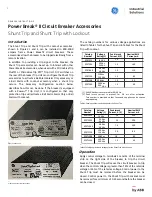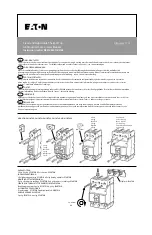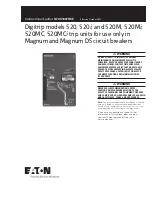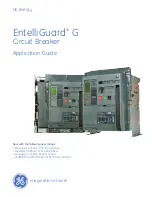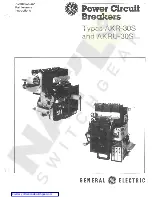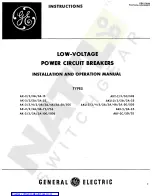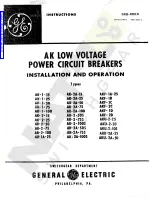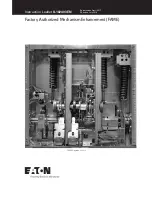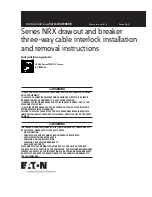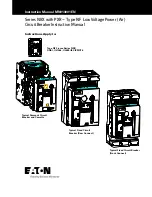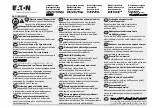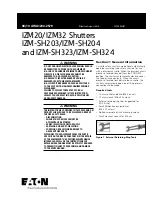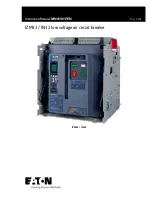
IB 6.2.11.1-1C
Page 4
ABB
Do not tamper with the interference blocking
;
equipment damage and/or injury to operating personnel
can occur when these blocks are removed.
7. Lift the circuit breaker securely. Use either the lifting
yoke assembly 709770-T05 or other sturdy lifting
device to position the circuit breaker on the cubicle
rails.
8. Pull out the cradle rails, then lower the circuit breaker
so that the positioning pins (two on each side of the
circuit breaker) rest in the cut-out sections of each
track.
9. Remove the lifting yoke and push the circuit breaker
toward the compartment. The circuit breaker will slide
in the cut-out sections of the tracks until the positioning
pins reach the end of the cut-outs. Push down on the
two track latches (one on each side of the breaker),
while simultaneously pushing the breaker into the
compartment until the racking cams stop against their
guides on the cradles. The circuit breaker should
remain in the disconnected position until system
checkouts have been completed.
10. Set the thresholds and time delays of the MPSC-
2000 solid state trip system. Using the circuit breaker
coordination information, adjust the settings of the
MPSC-2000 to the desired threshold (pick-up) and time
delay settings (instructions for setting the trip device
are contained in IB 6.1.2.8-1A). This must be done
before the circuit breaker is put into service. ABB does
not provide coordination information unless contracted
to do so by the purchase order.
11. On electrically operated (EO) models, position the
motor disconnect switch in the OFF position. This is
solely to prevent spring charging as the secondary
disconnects mate during racking.
12. To rack the circuit breaker to the test position for
evaluation, close the switchgear door, then lift the
shutter covering the racking shaft. Insert the racking
crank and turn the crank in a clockwise direction to
begin racking. Racking position indicators between the
front escutcheon and the dust plate will indicate relative
circuit breaker position. It may be necessary to move
the crank either clockwise or counterclockwise in the
test position until the proper position is reached to allow
the shutter to drop. Spring charging and/or breaker
closing is not possible with the racking shutter door
open.
13. With tests complete, the circuit breaker can be
racked to the connected position using a procedure
similar to (12) above.
CIRCUIT BREAKER ESCUTCHEON FEATURES
The K-Line Plus low voltage power circuit has a
number of standard features and can be equipped with
numerous other optional features. Refer to Figure 1 as
the features are discussed below.
Circuit Breaker Nameplates
- There are two
nameplates on the circuit breaker. The brief nameplate
on the escutcheon provides information regarding the
manufacturer’s name and address, type of circuit
breaker design, frame size, serial number of the circuit
breaker, and date of manufacture. The main breaker
nameplate is located on the breaker frame, and
provides additional information including the breaker
operating voltages and currents, interruption ratings,
and nominal control voltages. When contacting ABB
with questions on the circuit breaker, always refer to
the serial number found on these plates.
Manual Closing Handle
- (not shown) On manually
operated (MO) circuit breakers, this T-shaped handle is
used to simultaneously charge the close springs then
close the circuit breaker main contacts in one
continuous downward stroke.
MPSC-2000 Trip System
- The MPSC-2000 trip
system consists of the microprocessor-based trip
device, a current sensor for each phase of the circuit
breaker, a magnetic latch assembly, and an
interconnecting harness. This direct-acting trip device
comes complete with long time delay, short time delay,
instantaneous, and ground delay tripping capabilities.
A self-monitor light on the front of the trip system
flashes approximately once per second, when the
circuit breaker is closed with current flowing, to signal
that the trip system is functioning satisfactorily. Refer to
the complete description of the features and operation
of the MPSC-2000 in bulletin IB 6.1.2.8-1A.
Automatic Trip Indicator
- The automatic trip indicator
is a standard feature of K-Line Plus circuit breakers
providing visual indication that an automatic trip due to
overcurrent has occurred. Additional visual indication
of overcurrent trip appears on the MPSC-2000 trip
system discussed above.
When an overcurrent trip has occurred, this white
indicator will extend from the front escutcheon
approximately one-half inch. The action of this
indicator actuates two optional accessories, the R/S
(bell) alarms and the Trip Lockout. When so equipped,
the R/S contacts change state when the automatic trip
indicator "pops" out. The R/S (bell) alarms are
available with one normally open (N.O.) and one




















